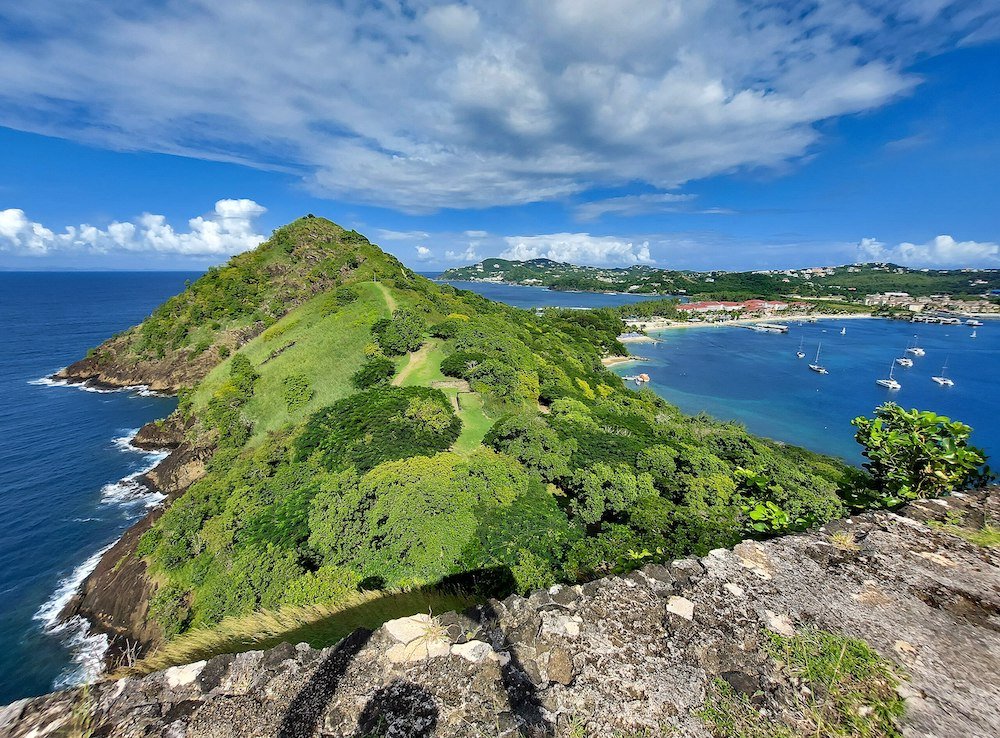
Thinking of visiting Pigeon Island St Lucia on your next holiday?
Pigeon Island, a quintessential emblem of St. Lucia’s rich heritage, holds a storied past that intertwines with the broader tapestry of Caribbean history.
Originally isolated from the mainland, this 44-acre islet was first inhabited by the Arawak people, later becoming a pivotal site during the colonial struggles between France and Britain in the 18th century.
The British, recognizing its strategic importance, fortified the island, remnants of which stand today as a testament to its historical significance.
The causeway, constructed in 1972, transformed Pigeon Island from an islet into a peninsula, thereby weaving it permanently into the fabric of St. Lucia’s landscape.
Nestled on the northwest coast of St. Lucia, Pigeon Island St. Lucia serves as a beacon of natural beauty and historical significance.
Its strategic position provided a vantage point for monitoring French naval activities, making it a key military site.
Today, this geographical marvel, embraced by the Caribbean Sea’s azure waters, is a lush, inviting haven for visitors from around the globe.
Its unique location, combined with its rich biodiversity and historical ruins, makes Pigeon Island a microcosm of Caribbean allure.
Pigeon Island St. Lucia is not just a historical treasure trove; it’s also a vibrant hub of activities and attractions.
From the serene beaches that flank its shores to the majestic Fort Rodney, visitors can immerse themselves in both relaxation and adventure.
Hiking enthusiasts will find solace in trails that offer panoramic views of St. Lucia and the Caribbean Sea, while history buffs can explore the ruins that dot the landscape, including military barracks and cannons.
The island also hosts the St. Lucia Jazz Festival, a premier event that transforms the site into a lively celebration of music and culture, drawing artists and spectators from across the world.
Whether it’s snorkeling in the crystal-clear waters, enjoying a picnic under the shade of tropical trees, or delving into the island’s past, Pigeon Island St. Lucia presents a diverse palette of experiences waiting to be discovered.
By blending historical intrigue with natural beauty and a plethora of activities, Pigeon Island St. Lucia stands as a testament to the island’s dynamic heritage and vibrant present.
It invites visitors to step into a world where history and nature coalesce, offering an unforgettable journey into the heart of the Caribbean.
The Historical Significance of Pigeon Island
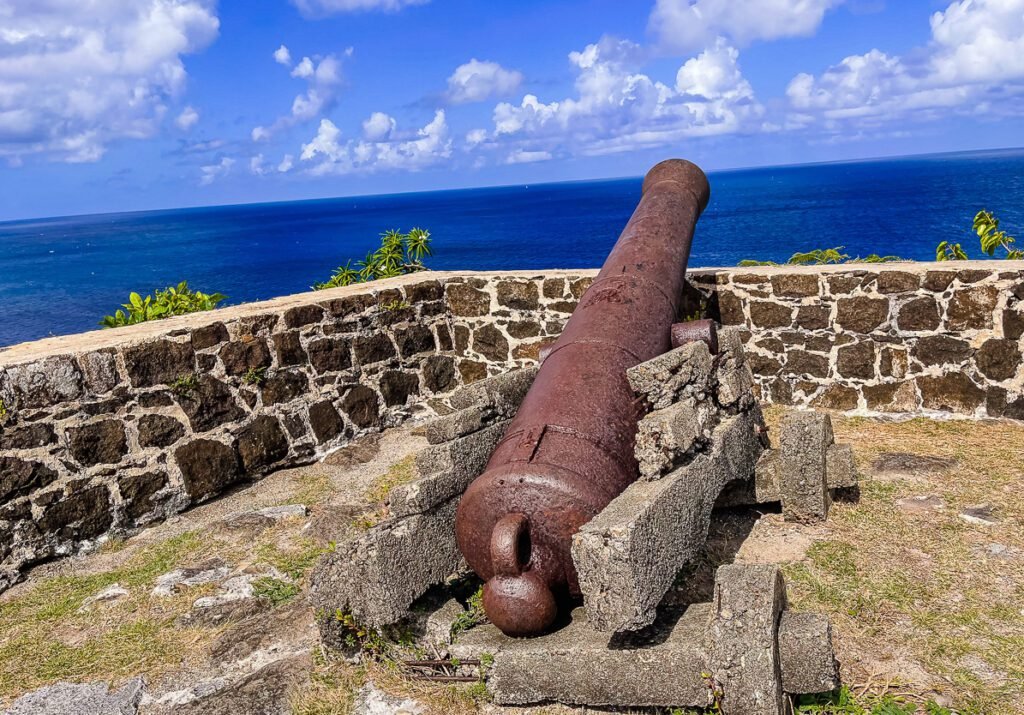
Historical Timeline: From the Early Inhabitants to Present-Day
Pigeon Island’s rich tapestry of history stretches back over centuries, tracing the evolution of this magnificent landscape from its earliest inhabitants to its current status as a beacon of cultural heritage.
Initially, it served as a seasonal settlement for the Amerindians, particularly the Arawaks and the Caribs, who were drawn to its abundant resources and strategic location.
The evidence of their presence is still part of the island’s lore, adding a layer of mystique and reverence to its already captivating scenery.
As European explorers set their sights on the Caribbean, Pigeon Island became a prized asset due to its vantage point and natural harbors.
The 16th through the 18th centuries saw the island morph into a naval base, especially under British control, who fortified the island in response to the strategic naval importance it held in their rivalry with the French for control over the Caribbean.
The remnants of Fort Rodney, named after the British Admiral George Rodney, stand as a testament to this era, overlooking the sea and silent witness to the battles waged on its waters.
The Role of Pigeon Island in St. Lucia’s Colonial History
Pigeon Island played a pivotal role in the colonial tug-of-war between the French and the British over St. Lucia, which changed hands 14 times in their battles for supremacy.
Its strategic importance was magnified during the 18th century when Admiral Rodney used the island as a lookout point and naval base to monitor French movements from Martinique.
His successful capture of the French-held island of Grenada was partly attributed to the strategic advantage Pigeon Island provided, a fact that has etched the island firmly into the annals of Caribbean maritime history.
Restoration and Preservation Efforts
Recognizing the historical and natural significance of Pigeon Island, concerted efforts have been made to preserve its heritage.
The transformation of the island into a National Landmark in 1979 marked the beginning of a dedicated journey towards restoration and conservation.
Archaeological digs have unearthed artifacts that shed light on its Amerindian past, while restoration projects have breathed new life into the colonial military installations, making them accessible to the public and serving as educational platforms.
These efforts have not only preserved the island’s tangible history but have also ensured the conservation of its natural beauty, allowing native flora and fauna to thrive.
Today, Pigeon Island stands not just as a monument to its tumultuous past but as a shining example of the balance between preserving history and embracing the future.
Through these preservation efforts, Pigeon Island invites visitors from around the globe to step back in time, offering a unique lens through which to view the complex tapestry of Caribbean history and culture.
Exploring the Natural Beauty of Pigeon Island
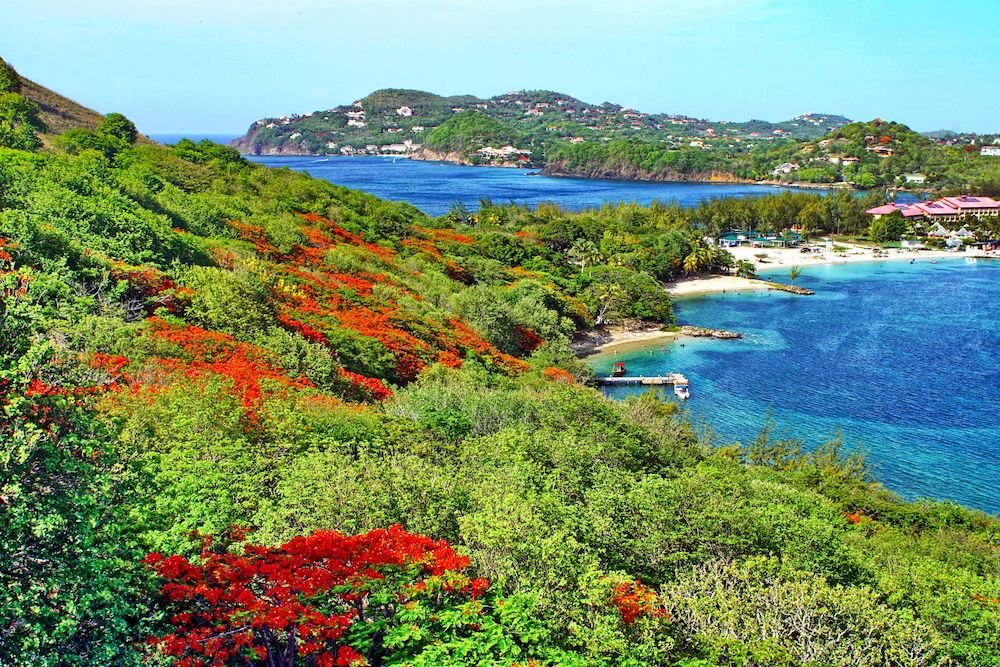
Pigeon Island, a lush oasis off the coast of St. Lucia, is not just a historical marvel but a testament to the island’s natural beauty.
This section will guide you through the verdant landscapes, diverse ecosystems, and serene beaches that make Pigeon Island a must-visit for nature lovers and adventure seekers alike.
Flora and Fauna Unique to the Island
The flora and fauna of Pigeon Island are as diverse as they are unique, with the island serving as a microcosm of St. Lucia’s rich biodiversity.
The island’s vegetation ranges from coastal dry forests to tropical rainforests, creating a haven for wildlife.
As you traverse the island, you’ll encounter a variety of bird species, from the majestic frigatebirds to the melodious warblers, making it a birdwatcher’s paradise.
The island is also home to numerous species of reptiles and a colorful array of butterflies, each adding to the island’s vibrant ecosystem.
Beaches and Hiking Trails
Pigeon Island’s beaches are among its most cherished treasures.
The two main beaches, gently hugging the Caribbean Sea, offer crystal-clear waters and soft, golden sands, ideal for relaxation or a refreshing swim.
For the more adventurous, the island boasts several hiking trails that promise breathtaking views and intimate encounters with the island’s natural wonders.
The trail to Fort Rodney, for example, is not just a journey through lush landscapes but a walk through history, culminating in panoramic views that stretch across the ocean to the mainland of St. Lucia.
Best Spots for Photography and Nature Watching
Every corner of Pigeon Island presents an opportunity for stunning photography and nature watching.
The lookout point from Fort Rodney offers a sweeping vista of the surrounding sea and St. Lucia’s coastline, a perfect backdrop for capturing the essence of the Caribbean.
The island’s northern tip, with its rocky outcrops and waves crashing against the shore, provides a dramatic setting for photographers and nature enthusiasts alike.
For those interested in the subtler beauty of the island, the varied ecosystems along the hiking trails offer endless opportunities to observe and photograph the island’s flora and fauna in their natural habitat.
Pigeon Island’s natural beauty is a testament to St. Lucia’s commitment to preserving its natural heritage.
As you explore the beaches, trails, and hidden corners of the island, you are invited to immerse yourself in the beauty and tranquility of this exceptional destination.
Adventure and Activities on Pigeon Island
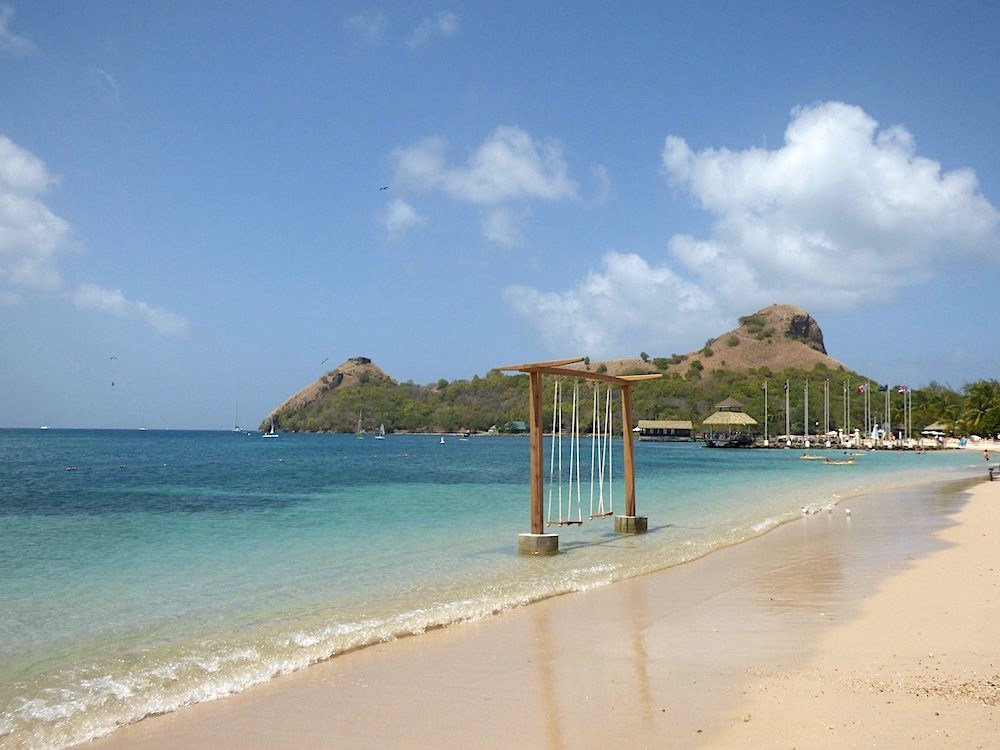
Pigeon Island, St. Lucia, is not just a bastion of history and natural beauty but also a playground for adventure seekers and cultural enthusiasts.
From the challenging hikes that reward you with stunning vistas to the crystal-clear waters inviting you to explore its depths, the island offers a variety of activities to fill your day with excitement and discovery.
Hiking on Pigeon Island offers an intimate exploration of its diverse landscapes and historical sites.
The main trails lead adventurers through lush foliage, opening up to reveal breathtaking views and significant historical ruins.
- Fort Rodney Trail: This trail leads to the summit of Fort Rodney, offering panoramic views of the Caribbean Sea and the St. Lucia coastline. The hike is moderate in difficulty, suitable for most fitness levels, and takes about 30 minutes to reach the top. Along the way, hikers can explore the remnants of military fortifications, including cannons and barracks.
- Signal Peak Trail: For those seeking a more challenging hike, Signal Peak, the highest point on the island, provides a more strenuous path. This hike takes approximately 45 minutes to an hour and rewards hikers with the most spectacular 360-degree views of St. Lucia and the surrounding waters.
Both trails are well-marked and offer numerous opportunities for wildlife watching and photography. Hikers are advised to wear comfortable shoes and bring water and sun protection.
Water Activities: Snorkeling, Kayaking, and Sailing
The waters around Pigeon Island are as inviting as its trails. With its protected bays and clear waters, the island is a perfect spot for snorkeling, kayaking, and sailing.
- Snorkeling: The calm waters around the island are home to vibrant coral reefs and a diverse marine life. Snorkelers can expect to see a variety of tropical fish, sea turtles, and perhaps even the occasional octopus.
- Kayaking: Paddle along the coastline of Pigeon Island to explore its natural beauty from the water. Kayaking offers a serene way to enjoy the island’s scenic vistas and tranquil beaches.
- Sailing: Take to the waters with a sailing excursion that offers a unique perspective of Pigeon Island and the wider St. Lucia landscape. Whether you’re an experienced sailor or trying it for the first time, the experience is unforgettable.
Special Events: Jazz Festival and Other Cultural Celebrations
Pigeon Island plays host to some of St. Lucia’s most vibrant cultural events, including the renowned St. Lucia Jazz Festival.
This event, held annually, transforms the island into a stage for world-class musicians and artists from around the globe, offering a blend of jazz, R&B, and Caribbean music.
- St. Lucia Jazz Festival: A highlight in the island’s calendar, the Jazz Festival attracts music lovers and performers to its open-air venue, set against the backdrop of Pigeon Island’s stunning natural beauty.
- Cultural Celebrations: Throughout the year, Pigeon Island hosts a variety of other events and festivals that celebrate St. Lucia’s rich cultural heritage, including Creole Day and Independence Day festivities.
These activities and events showcase the diverse experiences Pigeon Island offers to visitors, from the tranquility of nature to the exhilaration of adventure and the warmth of cultural celebrations.
Whether you’re hiking to historic ruins, gliding over coral reefs, or swaying to the rhythms of jazz, Pigeon Island promises memorable experiences for every traveler.
Pigeon Island National Landmark
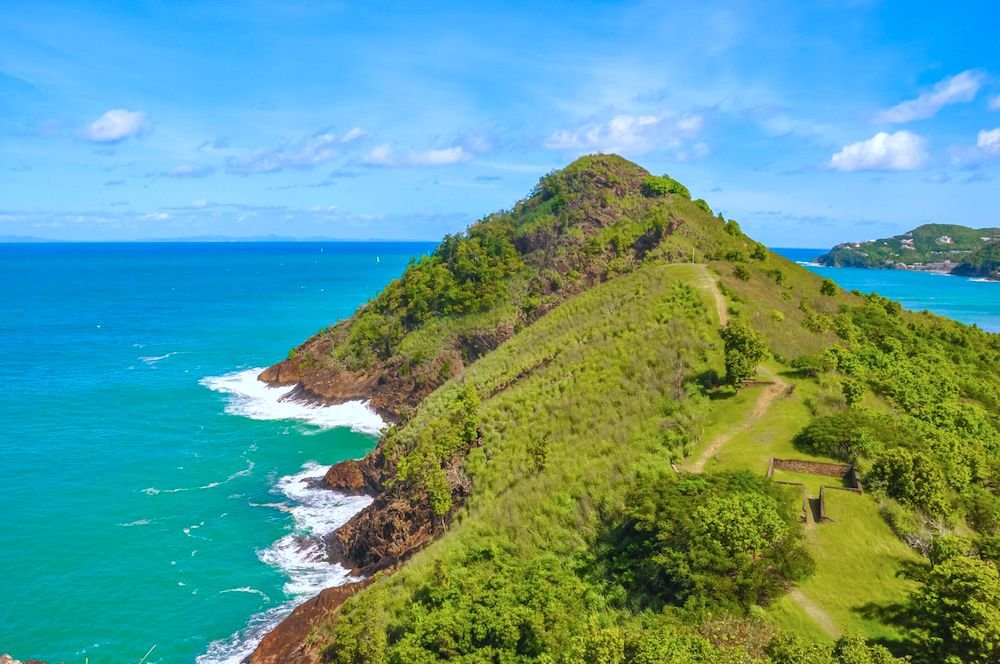
Pigeon Island, a jewel in the crown of St. Lucia’s natural and historical treasures, is recognized not just for its breathtaking beauty but also for its profound historical significance.
Designated as a National Landmark, this designation underscores the island’s role in the cultural and historical narrative of St. Lucia and the Caribbean at large.
The Significance of the Designation as a National Landmark
The designation of Pigeon Island as a National Landmark serves as a testament to its historical importance and a commitment to preserving its natural environment.
This status helps to protect the island’s rich biodiversity, archaeological sites, and historical structures, ensuring they remain untouched by the rapid development seen elsewhere.
It also highlights the island’s role in shaping the history of St. Lucia and the Caribbean, from its use by the Amerindians to its strategic military significance during colonial times.
As a National Landmark, Pigeon Island stands as a symbol of national pride and a reminder of the complex tapestry of Caribbean history.
Exploring the Fort Rodney ruins and military installations
One of the key attractions on Pigeon Island is the ruins of Fort Rodney, a British military installation named after Admiral George Rodney.
Visitors can explore the remnants of this fort, which played a crucial role during the battles for control of the Caribbean seas in the 18th century.
The fort’s well-preserved gun emplacements and barracks offer a glimpse into the strategic military planning of the era.
Hiking up to the fort provides not only a history lesson but also offers spectacular views of the island and the surrounding waters, making it a must-visit for history buffs and nature lovers alike.
Adjacent to Fort Rodney, visitors will find other military installations, including signal stations and ammunition magazines, each telling a part of the island’s extensive military history.
These sites allow visitors to step back in time and imagine the island’s past as a bustling military base.
Educational Tours and Resources Available
For those looking to delve deeper into the rich history and natural beauty of Pigeon Island, educational tours and resources are available.
These tours, led by knowledgeable guides, offer insights into the island’s significance in Caribbean history, its ecological importance, and the efforts to preserve this unique site.
Visitors can learn about the native plants and animals, the historical use of the island by indigenous peoples, and its strategic importance in naval battles.
Educational materials, including brochures, maps, and interactive displays, are available at the visitor center, providing a comprehensive overview of the island’s history, flora, and fauna.
These resources make a visit to Pigeon Island not only a recreational outing but also an informative experience, enriching visitors’ understanding of St. Lucia’s heritage.
Planning Your Visit to Pigeon Island

A visit to Pigeon Island, St. Lucia, offers an enriching blend of natural beauty, historical exploration, and outdoor adventure.
To ensure you have a memorable and enjoyable experience, planning your visit with key information on timing, fees, and practical tips can make all the difference.
Best Times to Visit: Weather Considerations and Seasonal Attractions
St. Lucia enjoys a tropical climate year-round, making Pigeon Island an attractive destination in any season.
However, the best time to visit is from December to April, during the dry season, when the weather is most favorable for outdoor activities.
The island’s lush landscapes are particularly vibrant, and the clear skies offer spectacular views from hiking trails and beaches.
Seasonal attractions, such as the St. Lucia Jazz Festival held on Pigeon Island in May, provide unique cultural experiences that coincide with good weather.
Keep in mind that this period is also peak tourist season, so expect more visitors and a lively atmosphere.
Entrance Fees, Opening Hours, and Tour Options
- Entrance Fees: A nominal fee is charged for entry to Pigeon Island National Landmark. These funds contribute to the conservation and maintenance of the site. Discounts may be available for children and local residents.
- Opening Hours: Pigeon Island is open to visitors from early morning until sunset, allowing ample time to explore the beaches, trails, and historical ruins. Specific opening hours can vary, so it’s advisable to check in advance.
- Tour Options: Guided tours offer insightful explorations of the island’s history, flora, and fauna. Options range from historical tours focusing on the military ruins and colonial past to nature walks highlighting the island’s ecological diversity. Private and group tour options are available, catering to different interests and preferences.
Tips for Visitors: What to Bring and How to Make the Most of Your Visit
- What to Bring: Comfortable walking shoes are a must for exploring the hiking trails and historical sites. Sun protection, including hats, sunglasses, and sunscreen, is essential under the Caribbean sun. Don’t forget to bring water to stay hydrated and snacks for energy, especially if you plan to spend the whole day on the island.
- Making the Most of Your Visit: Start your day early to avoid the hottest part of the day and to experience the tranquility of the island before it gets busier. Allocate enough time to explore both the natural and historical attractions without rush. If you’re interested in photography, the golden hours at sunrise and sunset offer magical light for capturing the island’s beauty.
- Respect the Environment: As a National Landmark, preserving the natural and historical integrity of Pigeon Island is paramount. Visitors are encouraged to follow guidelines, such as staying on marked trails and disposing of trash properly, to minimize their environmental impact.
Conclusion
Pigeon Island, St. Lucia, stands as a testament to the island’s rich tapestry of history, natural beauty, and cultural vibrancy.
From the historic ruins of Fort Rodney to the lush trails and pristine beaches, this National Landmark offers a unique blend of educational and recreational opportunities.
The island’s significance is magnified by its role in the colonial history of the Caribbean and its commitment to preserving the natural environment and historical integrity for future generations.
The main attractions of Pigeon Island—the breathtaking views from Fort Rodney, the serene beauty of its beaches, the challenging and rewarding hiking trails, and the vibrant cultural events like the St. Lucia Jazz Festival—provide compelling reasons for anyone to visit.
The island serves as a perfect destination for history buffs, nature lovers, adventure seekers, and those looking to relax in a picturesque setting.
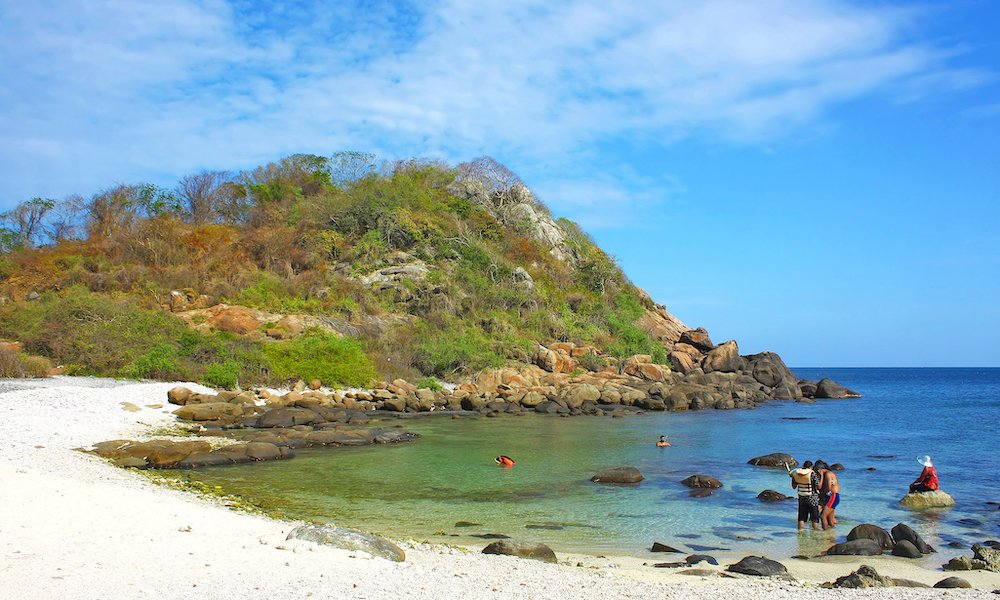
FAQ’s About Pigeon Island St Lucia:
How much does it cost to go to Pigeon Island St Lucia?
The entrance fee for Pigeon Island National Landmark is relatively modest, making it an accessible attraction for many visitors.
While prices can vary and may be subject to change, generally, adults can expect to pay around 8 USD, and there may be reduced rates for children and local residents.
It’s always a good idea to check the latest information before planning your visit as fees can be updated.
Can you walk to Pigeon Island St Lucia?
Pigeon Island is connected to the mainland of St. Lucia by a causeway, making it easily accessible on foot for those staying nearby.
Walking to the island offers a pleasant experience, allowing visitors to enjoy the scenic views along the way.
However, if you’re staying further away, you might consider other transportation options like a taxi or a bus to reach the causeway’s starting point.
Why is it called Pigeon Island in St Lucia?
Pigeon Island was named for the flocks of rock pigeons that inhabited the island.
These birds were a significant source of food for the island’s early inhabitants.
Over time, the name stuck, and Pigeon Island became known for both its historical significance and natural beauty, despite changes in the pigeon population and the island’s ecosystem.
Are there pigeons on Pigeon Island?
Historically, Pigeon Island was named after the rock pigeons that were found in abundance.
However, with changes in the environment and human development, the number of pigeons on the island has been affected.
While there may still be birds, including pigeons, on the island, they are not as prominently featured as the name might suggest.
Is St Lucia cheap or expensive?
St. Lucia can cater to a wide range of budgets, but it is generally considered a mid-range to expensive destination, especially when compared to some other Caribbean islands.
The cost of visiting St. Lucia depends on factors like accommodation, dining choices, and activities.
Luxury resorts and fine dining can make it an expensive getaway, but there are also budget-friendly options available for accommodations and meals.
Is St Lucia an expensive island?
Yes, St. Lucia is considered one of the more expensive Caribbean islands, particularly because of its popular luxury resorts, boutique hotels, and high-end dining options.
However, the island also offers a variety of experiences and accommodations that can suit budget travelers, such as guest houses, local eateries, and free natural attractions.
Why is St Lucia famous?
St. Lucia is famous for its stunning natural beauty, including the iconic Pitons, lush rainforests, and beautiful beaches.
The island is also renowned for its luxurious resorts, vibrant culture, and rich history, which includes both indigenous and colonial influences.
St. Lucia’s warm, welcoming atmosphere and diverse landscape make it a popular destination for tourists seeking both relaxation and adventure.
How do you explore Pigeon Island?
Pigeon Island can be explored in various ways to suit different interests and physical abilities.
Visitors can walk along the beaches, hike up to Fort Rodney and Signal Peak for spectacular views, or participate in guided tours that offer insights into the island’s history and natural environment.
Snorkeling, kayaking, and sailing are also popular activities for those looking to experience the island’s marine life and coastal beauty.
What is Saint Lucia best known for?
Saint Lucia is best known for its dramatic twin peaks, the Pitons, which are UNESCO World Heritage sites.
The island’s lush landscapes, beautiful waterfalls, and stunning beaches also contribute to its fame.
Additionally, St. Lucia is celebrated for its rich cultural heritage, which includes Creole cuisine, vibrant festivals, and warm, friendly people.
The combination of natural beauty, cultural richness, and luxurious accommodations makes St. Lucia a sought-after destination in the Caribbean.





